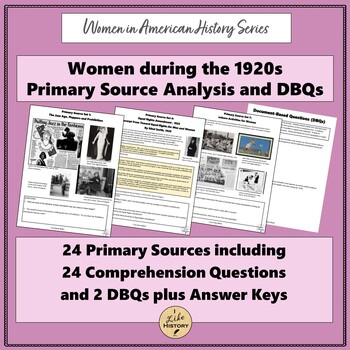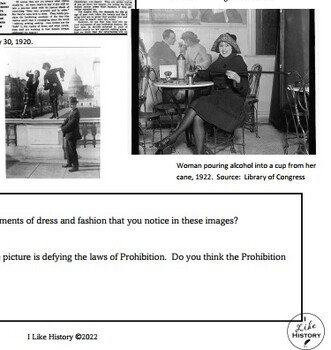Women in the 1920s: DBQ and Primary Sources * Flappers * Jazz Age * US History
- PDF
- Easel Activity
Description
This 21-page resource with 24 primary sources, 24 comprehension questions plus 2 DBQ prompts gives students a chance to identify the tensions for women between tradition and progress in the 1920s, along with the new opportunites. The first page includes Background, Notes on Primary Sources and Teacher Notes.
Here’s a chance for students to read documents and look at images that shed light on issues facing women in the 1920s. These include newspaper pictures and articles about flappers, a flapper's own writing about her life, the Equal Rights Amendment, an argument against the E.R.A., pictures of women at work, data about women's work, women's recreation and leisure activities, the impact of consumerism and a study on life in the 1920s from the famous Middletown sociological study. There are, of course, so many more documents and issues of the 1920s such as the Red Scare and the Scopes trial but these documents cover a broad range of what women experienced. Many of the political events of the time still minimized, or even excluded, women's input although sometimes women provided reflections, opinions and even participation when possible. Nonetheless, the included primary sources highlight much of the modern advances and developments for women which stood in contrast to many of the traditional views and expectations that held sway in America at the time.
Assign just one, a few or all of the sources depending on time constraints and student interest.
Primary sources include letters, photos, newspaper articles, reports and other documents. Each page of primary sources includes comprehension questions at the end in order for students to analyze perspectives, consider key ideas and identify bias.
Included is a one-page sheet that explains what primary sources are and how to analyze them using specific questions through a process called HAPPY. There is also a page at the end for students to apply the HAPPY process to one source.
Two DBQ prompts are included at the end with instructions on how to create a response to the prompt.
An Answer Key to all the comprehension questions and the DBQ prompts are available at the end of the packet.
This is excellent practice for all high school students, particularly Honors and AP students, but all students will find these resources engaging.
This is also available as a digital resource through Easel so students may complete it online.
Please check out my other Primary Source Analysis and DBQ Teaching Resources about Women's History
* Women in Colonial America: DBQ's and Primary Sources
* Women of the American Revolution: DBQ's and Primary Sources
* Early Women's Rights 1840-1865: DBQ's and Primary Sources
* Women during the Industrial Era: DBQ's and Primary Sources
* Women's Suffrage Movement: 1865-1920: DBQs and Primary Sources
* Women in the U.S. Military during World War II: DBQ's and Primary Sources
More are always being added so check back frequently!
Do you love historical fiction? My novel, Hearts at War, features a white girl and a Japanese-American boy who are childhood friends whose growing attraction to one another in high school will be severed by war, family and social pressures once they enter college. They come of age in California and coincidence will throw them together again in the Pacific theater of war as they both serve in the military. Will they be able face the challenges of war and find a way back to each other? Available on Amazon or Kindle/Kindle Unlimited. Young Adults/Adults/Interracial Romance. I appreciate any reviews!
Thank you!
Christa Nonnemaker






